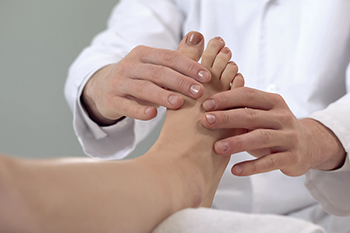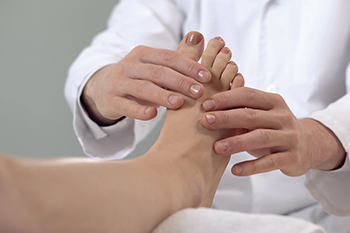Blog
Diagnosing Sesamoiditis

Many people may not know that there are two pea-shaped bones located under the big toe that are known as the sesamoids. When the tendons that are attached to these bones become inflamed from overuse of the front of the foot, a condition known as sesamoiditis can occur. Individuals with sesamoiditis can experience pain in the ball of their feet where the affected sesamoids are located, and they might find it difficult to point their toes. There are several things that a medical professional might do to diagnose a case of sesamoiditis. First, a physical examination will be performed on the affected area, analyzing the movement and flexibility of the big toe. If sesamoiditis is likely in a patient, then an X-ray might be performed to get a better sense of the state of the patient’s bones. In some cases, bone scans might be even more helpful, as these images make more things visible than X-rays. If you have sesamoiditis, do not hesitate to consult with a podiatrist.
Sesamoiditis is an unpleasant foot condition characterized by pain in the balls of the feet. If you think you’re struggling with sesamoiditis, contact one of our podiatrists of Pennsylvania. Our doctors will treat your condition thoroughly and effectively.
Sesamoiditis
Sesamoiditis is a condition of the foot that affects the ball of the foot. It is more common in younger people than it is in older people. It can also occur with people who have begun a new exercise program, since their bodies are adjusting to the new physical regimen. Pain may also be caused by the inflammation of tendons surrounding the bones. It is important to seek treatment in its early stages because if you ignore the pain, this condition can lead to more serious problems such as severe irritation and bone fractures.
Causes of Sesamoiditis
- Sudden increase in activity
- Increase in physically strenuous movement without a proper warm up or build up
- Foot structure: those who have smaller, bonier feet or those with a high arch may be more susceptible
Treatment for sesamoiditis is non-invasive and simple. Doctors may recommend a strict rest period where the patient forgoes most physical activity. This will help give the patient time to heal their feet through limited activity. For serious cases, it is best to speak with your doctor to determine a treatment option that will help your specific needs.
If you have any questions please feel free to contact one of our offices located in Plymouth Meeting and Ambler, PA . We offer the newest diagnostic and treatment technologies for all your foot and ankle needs.
Causes of Diabetic Foot Pain

One of the chief symptoms of diabetes is chronic foot pain, which is common to most people with this disease. Three major causes of diabetic foot pain are nerve problems, circulatory problems, and infections. A condition known as peripheral neuropathy is the result of damage to the nerves that supply blood to the lower legs, feet, and toes. Specific to diabetics is sensory neuropathy, which results in extra sensitivity to pain in these areas. The diabetic may also experience a loss of sensation in this part of the body that contributes to the cracking and drying of the skin. Another cause of chronic foot pain is peripheral artery disease (PAD). This is the result of sustaining high levels of blood sugar that can clog the arteries and capillaries and slow the flow of blood to the feet and toes. The third most common cause of diabetic foot pain is infections. The diabetic is highly susceptible to infection from sores, cracks, and cuts. Because it is difficult to feel them when they occur, they often go unnoticed. Further, PAD makes it more difficult for these injuries to heal, causing ulcers and other more serious problems. If you are a diabetic and have chronic foot pain, please make an appointment with a podiatrist for an exam and diagnosis.
Diabetic foot care is important in preventing foot ailments such as ulcers. If you are suffering from diabetes or have any other concerns about your feet, contact one of our podiatrists from Pennsylvania. Our doctors can provide the care you need to keep you pain-free and on your feet.
Diabetic Foot Care
Diabetes affects millions of people every year. The condition can damage blood vessels in many parts of the body, especially the feet. Because of this, taking care of your feet is essential if you have diabetes, and having a podiatrist help monitor your foot health is highly recommended.
The Importance of Caring for Your Feet
- Routinely inspect your feet for bruises or sores.
- Wear socks that fit your feet comfortably.
- Wear comfortable shoes that provide adequate support.
Patients with diabetes should have their doctor monitor their blood levels, as blood sugar levels play such a huge role in diabetic care. Monitoring these levels on a regular basis is highly advised.
It is always best to inform your healthcare professional of any concerns you may have regarding your feet, especially for diabetic patients. Early treatment and routine foot examinations are keys to maintaining proper health, especially because severe complications can arise if proper treatment is not applied.
If you have any questions please feel free to contact one of our offices located in Plymouth Meeting and Ambler, PA . We offer the newest diagnostic and treatment technologies for all your foot and ankle needs.
Exercises That May Help Children With Flat Feet

When the arch of the foot is not fully developed, it is known as flat feet. The medical term for this ailment is called pes planus and it affects most babies when they are born. The arch will fully develop in most people in their teenage years and there are specific exercises and stretches that can be performed which may help with existing discomfort. Have your child stand on one foot as this is an effective method of using the small muscles inside of the foot and around the ankles as balance is maintained. A good exercise that can strengthen the toes is done when your child picks up marbles that are on the floor with their feet as this can help build up the arch. Ask your child to walk on a curb. This is an effective way for them to learn how to balance on narrow surfaces and will strengthen the ankle and arch and may help to gradually develop the foot. If you would like additional information about how to live with flat feet and possible ways to strengthen the arch, please confer with a podiatrist.
Flatfoot is a condition many people suffer from. If you have flat feet, contact one of our podiatrists from Pennsylvania. Our doctors will treat your foot and ankle needs.
What Are Flat Feet?
Flatfoot is a condition in which the arch of the foot is depressed and the sole of the foot is almost completely in contact with the ground. About 20-30% of the population generally has flat feet because their arches never formed during growth.
Conditions & Problems:
Having flat feet makes it difficult to run or walk because of the stress placed on the ankles.
Alignment – The general alignment of your legs can be disrupted, because the ankles move inward which can cause major discomfort.
Knees – If you have complications with your knees, flat feet can be a contributor to arthritis in that area.
Symptoms
- Pain around the heel or arch area
- Trouble standing on the tip toe
- Swelling around the inside of the ankle
- Flat look to one or both feet
- Having your shoes feel uneven when worn
Treatment
If you are experiencing pain and stress on the foot you may weaken the posterior tibial tendon, which runs around the inside of the ankle.
If you have any questions please feel free to contact one of our offices located in Plymouth Meeting and Ambler, PA . We offer the newest diagnostic and treatment technologies for all your foot and ankle needs.

